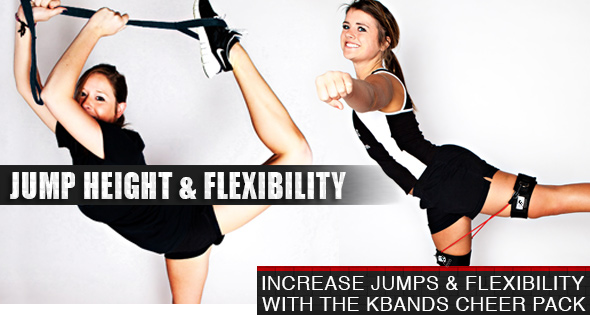Kbands Resisted Heel Stretch | Stability and Hip Strength With Cheer Bands
Increased flexibility and body control through a long range of motion are important to have success in cheerleading. Athletes will be able to take full advantage of the flexibility they have worked to gain by adding resistance to this advanced youth cheerleading drill.
This gained body control will give youth cheerleaders the tools to perform more difficult stunts. By switching from resisted to un-resisted sets athletes will achieve full muscle activation in their hips and quads, which will allow for longer and stronger holds during routines.
Those who have not yet achieved the flexibility and range of motion to control the heel stretch should begin to work stretching routines into their regular training programs. Utilizing the Kbands Stunt Strap will aid less advanced athletes develop more flexibility and a greater range of motion. Increasing flexibility will not just translate into greater success with the heel stretch, but will aid in mastering other stunts commonly used during cheerleading routines.
Kbands Resisted Heel Stretch | Stability and Hip Strength: Setup
To perform the Kbands resisted heel stretch athletes will need a set of Kbands Cheer Bands, room to properly execute the heel stretch, and a partner or coach to offer feedback during the youth cheerleading Kbands resisted heel stretch drill.
To begin the resisted heel stretch athletes will attach the Kbands Cheer Bands just above the knees and stand tall with their hands at their side. Proper body positioning is crucial for the execution of the heel stretch. It is easy to let the chest dip, round the back, or overarch the low back at the top of the heel stretch. As athletes perform the heel stretch they should work to ensure they achieve the proper position of the back, leg, and hips. Coaches and partners observing the heel stretch should critique the athlete's form and execution technique to ensure they have the proper positioning.
If an athlete has the flexibility to perform the heel stretch but the resistance is to much, athletes may consider switching to a band with less resistance. Cheerleaders should work to perform the resisted heel stretch with resistance provided by the green bands. However, if less resistance is needed to successfully complete the heel stretch, red resistance bands may replace the green resistance bands. Cheerleaders need to work on their strength with the red resistance bands but continually work to improve so they can properly execute the resisted heel stretch exclusively the green resistance bands.
Kbands Resisted Heel Stretch | Stability and Hip Strength: Execution
Athletes will get into a good starting position and, with their leg fully extended, will quickly raise their leg, grasp the foot at the highest point, and hold for 3 seconds. Athletes need to keep their chest tall and be sure not to over arch the low back as the foot is grasped at the top of the heel stretch.
Holding the foot at the top forces cheerleaders to maintain good body positioning and challenges balance and core strength. The foot hold at the top of the heel stretch is an important aspect of the execution of the heel stretch. Partners and cheerleaders performing the heel stretch stunt need to be sure they are keeping a tight core, not hunching over or rounding the back, and the leg being extended is held as straight as possible. If proper form cannot be achieved and held, athletes and coaches should consider using less resistance for the heel stretch drill. Cheerleaders and coaches can use less resistance for the heel stretch as they work to strengthen the hips and upper legs.
Perform 2 resisted heel stretches with each leg before unclipping the resistance and performing 2 un-resisted repetitions of the heel stretch with both legs. During the un-resisted repetitions of the heel stretch athletes should work for a longer and more controlled range of motion and hold at the top.
Athletes will see greater results from the heel stretch drill by switching between resisted and un-resisted sets. This rotation will allow for greater muscle activation. By forcing muscles to work harder with resistance, more muscles are recruited to aid in the movement. This increase in muscle recruitment results in the firing of more muscle fibers while un-resisted sets of the heel stretch are being performed. This extra muscle activation will mean quicker leg raises, longer holds, and greater body control through a longer range of motion. This extra muscle activation will also help bring new and more challenging stunts into the training sessions and during competition.
Kbands Resisted Heel Stretch | Stability and Hip Strength: Drills With Cheer Bands
By working the resisted heel stretch into a regular workout routine cheerleaders will see great improvements in both their hip and upper leg strength. Improvements in these two areas, as well as flexibility, can help those participating in youth cheerleading to advance in their stunts and training. The heel stretch movement and the hold following it are excellent ways for those participating in youth cheerleading to advance in their stunts and routines. With greater core strength, balance, and body control youth cheerleaders will be able to practice and successfully perform more difficult stunts.
Cheerleaders should actively perform stretching routines as a part of their regular workout routine if they currently lack the flexibility to perform the heel stretch. Cheerleaders should also utilize the Kbands Stunt Strap to help improve flexibility and range of motion in the hips. Increasing flexibility in the hips and upper legs will translate into greater results and advancement in the heel stretch. Greater flexibility also means advancement in other areas and stunts performed during youth cheerleading training sessions.

